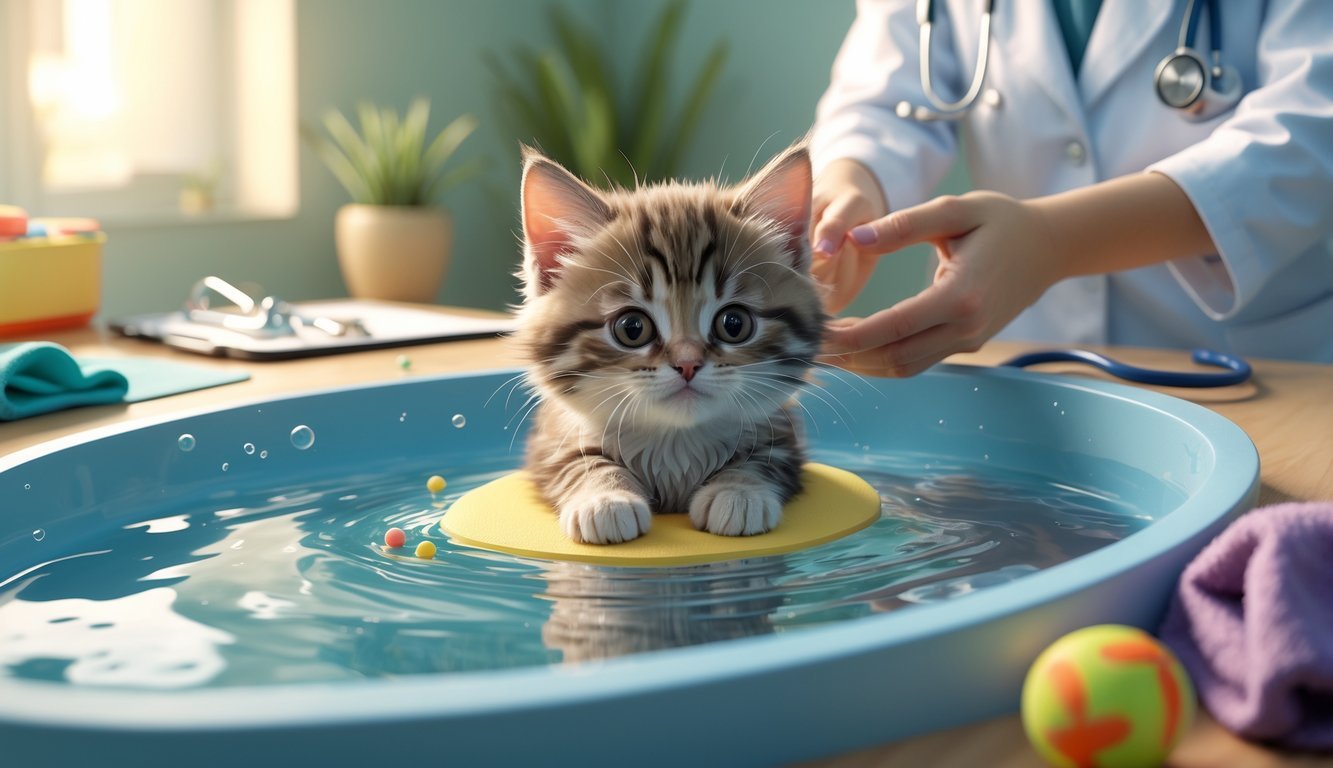PsychNewsDaily Publishers
100 Summit Drive
Burlington, MA, 01803
Telephone: (320) 349-2484
PsychNewsDaily Publishers
100 Summit Drive
Burlington, MA, 01803
Telephone: (320) 349-2484
Kittens with swimmer syndrome have splayed legs, making walking difficult. Early care, including taping and physical therapy, can significantly improve their mobility and strength.

Some kittens come into this world with swimmer syndrome. Their legs splay out to the sides, and walking just isn’t really possible at first.
It’s a tough sight, honestly, but with some patience and the right care, a lot of these kittens get better. They can even learn to walk just like any other cat.
This little kitten who beat swimmer syndrome proves that early support and gentle treatment really can help them grow strong.
Ever wonder how such a small kitten manages to overcome something like this? Usually, it’s a mix of gentle leg taping, a bit of physical therapy, and, honestly, a lot of love.
Watching a kitten slowly gain strength is pretty inspiring—especially for anyone who’s into animal rescue or just cares about pets.
If you ever end up caring for a kitten with swimmer syndrome, don’t lose hope. These little ones show us that early help can really change their lives, turning what looks like a struggle into a real success.

Swimmer syndrome affects how a kitten moves its legs. Their legs splay out to the sides, so walking is super hard, sometimes impossible.
People usually spot this condition early on, and there are signs you can learn to notice it.
Swimmer syndrome is congenital, so kittens are born with it. It mostly affects the muscles and tendons in their legs, making the limbs—especially the hind legs—spread out sideways.
Because of this, kittens end up flat on their bellies. They can’t pull their legs under themselves to stand or walk.
Their legs are just too weak. With some care, though, things can get better.
Some folks call it “Flat Kitten Syndrome” because of how these kittens look when they’re lying down.
You’ll usually notice swimmer syndrome in kittens just a few weeks old. Look for legs that splay out instead of tucking in.
Kittens might not stand, crawl, or scoot like their littermates. It’s pretty obvious when you see it.
Other signs you might spot:
A vet will check the kitten’s limbs and muscles. Diagnosis is mostly about watching how the kitten moves, but sometimes the vet checks for bone or muscle issues too.
Swimmer syndrome almost always starts at birth. It happens when the kitten’s muscles, tendons, or bones just don’t develop quite right in the womb.
Some causes can be:
Sometimes, how the kitten is positioned in the womb adds pressure and makes things worse. Early care and some physical therapy help a lot with muscle building and movement.
Both puppies and kittens can get swimmer syndrome, but there are some differences. The legs splay out in both, so they both struggle to move.
Puppies usually get it in their front legs as well, while kittens mostly have it in their hind legs. Treatment and support matter for both, but kittens tend to respond well to gentle exercise and stretching, especially if you start early.
If you notice these signs in a kitten or puppy, getting help fast really improves their chances of walking normally.

When a kitten has swimmer syndrome, helping it learn to walk isn’t easy. You’ll need to work with vets, try special therapy, and just be patient.
Caring teams and shelters do a lot to help kittens recover, step by step.
Kittens with swimmer syndrome usually have flat chests and legs that stick out to the sides. That shape makes standing or walking really tough.
They might slide around because their muscles are so weak.
These kittens can struggle to eat or clean themselves. You might notice they can’t keep up with siblings or have trouble exploring.
Early care is important to avoid muscle and bone problems.
Taking your kitten to the vet is a must. The vet checks the kitten’s limbs, muscles, and chest shape.
Sometimes, they’ll do X-rays or a physical exam to see how bad the swimmer syndrome is.
The vet also checks for other health problems. Once you know what’s going on, you can figure out a treatment plan.
You’ll get advice on how often to come back and check the kitten’s progress.
Physical therapy is really important for helping your kitten walk again. You’ll help your kitten stretch and lift its legs to build up muscle.
Gentle exercises get those little limbs moving the way they should.
You’ll work daily, doing short sessions of leg presses, massages, and balance activities.
Being consistent is what matters most here. Therapy keeps joints flexible and helps with pain as the kitten gets stronger.
Tape and traction help keep the kitten’s legs in the right position. Wrapping the legs gently stops them from spreading too far.
This kind of training teaches the kitten to put its paws down properly when standing.
Water therapy is awesome, too. Swimming or paddling in shallow water supports weak muscles without putting too much strain on them.
It’s a safe way for the kitten to practice moving its legs—and it’s actually kind of fun.
With time and care, most kittens get a lot better. In a few weeks or months, you’ll probably see better balance and stronger steps.
Some kittens even start running and playing with barely any help.
Watch for little wins, like standing without falling or walking across the room. Healing takes patience, but those small steps mean the kitten’s growing more independent.
Shelters and caretakers often give swimmer kittens extra attention. Foster homes sometimes provide physical therapy and daily human interaction.
These caregivers track each kitten’s needs and progress. Their support really boosts recovery, providing warmth and motivation.
You can help, too, by following their advice and giving plenty of love.

You might be wondering how to help a kitten with swimmer syndrome, or what their chances are for getting better.
It’s also good to know when they might improve, what problems to watch for, and how treatments like taping and exercises actually work.
Treatment usually means doing physical therapy to build up the kitten’s muscles and help it move better. You might use taping to keep their legs in the right position.
Early care and patience make a big difference.
A lot of kittens improve with regular care and therapy, but it really depends on how early you start and how bad the syndrome is.
Some kittens recover fully, while others might still have a bit of weakness.
Kittens usually show the most progress between 3 and 6 weeks old, but they can keep improving for several months.
Some outgrow the syndrome completely with good care, but it’s different for every kitten.
Complications can include joint problems, muscle weakness, or trouble walking if you don’t treat it. In really bad cases, kittens might end up with bone deformities.
Taping holds the kitten’s legs in a more natural position. This helps build muscle and teaches the kitten to stand and walk better.
You’ll need to change the tape often and be gentle with it.
Absolutely. You can try gentle leg massages and help your kitten stand up with support.
Guided walking works well too. These activities help your kitten get stronger and move better.
Just remember—be gentle, and stop right away if your kitten looks uncomfortable.